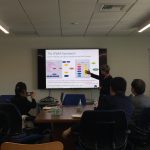Last month, the CM2 office was honored to host Dr. Anna Hersperger and postdoctoral researcher Chunhong Zhao of the Swiss Federal Research Institute WSL, to discuss their work on the CONCUR project. The CONCUR project aims to understand the role of spatial planning in urban transition. Planners often assume land use planning affects land change, but to date there has been little evaluation to see if this is true. This project seeks to remedy this, using three detailed case studies of North American and European cities. The research team was in town since Austin, TX is one of these case study cities. Seeing an excellent opportunity to connect their research with the center’s work on megaregions, Drs. Hersperger and Zhao were invited to speak to CM2 faculty and student researchers.
Anna M. Hersperger is head of the Land-Use System Group at the Swiss Federal Research Institute WSL. She received her doctorate from Harvard University in 2000 with a joint degree in Ecology and Landscape Architecture. Anna is an expert in spatial planning and landscape ecology. She examines the actors and driving forces behind land use change in urban and rural areas. The possibilities for controlling these processes are of central interest both for basic research and for spatial and landscape planning practice, for example in combating urban sprawl. Her current main project “CONCUR – From Plans to Land Change” is funded by an SNSF Consolidator Grant. Anna and her team are working on a better understanding of the strategic spatial planning processes in European metropolitan regions and on the integration of spatial planning into a land change model for urban regions.
The CONCUR project is divided into three steps:
- Developing a theoretical model for evaluating land change as correlated to spatial land planning
- Operationalizing this model
- Testing this model, using three case study cities (Austin, TX; Zurich, Switzerland; Bucharest, Romania)
To inform the modeling framework, this project began with a series of related projects that evaluated planning intentions/content, plan implementation, governance arrangements, and external conditions affecting plan making and plan implementation. An evaluation of plan intentions (which reviewed plans from dozens of cities across multiple continents) showed that often cities have intentions that are seemingly at odds with each other, such as land conservation and economic development. The number one intention among all plans was improving transportation followed by economic growth. Intentions were mapped spatially to see how to they affected future land change. Using the CLUMondo model, researchers are able to compare land use change with and without planning intervention. Researchers are in the process of interviewing local practioners and academics in each of the case study cities as well as conducting fieldwork to incorporate the measurement of plan making and plan implementation into the research.
As Dr. Hersperger pointed out, this approach to strategic spatial planning (similar to metropolitan planning in the US) can ideally then be scaled up to larger, land-based planning efforts. This talk gave CM2 faculty and student researchers a wonderful opportunity to learn about a new tool and approach to facilitate multi-jurisdictional coordination, which can be used in future megaregional planning research.



